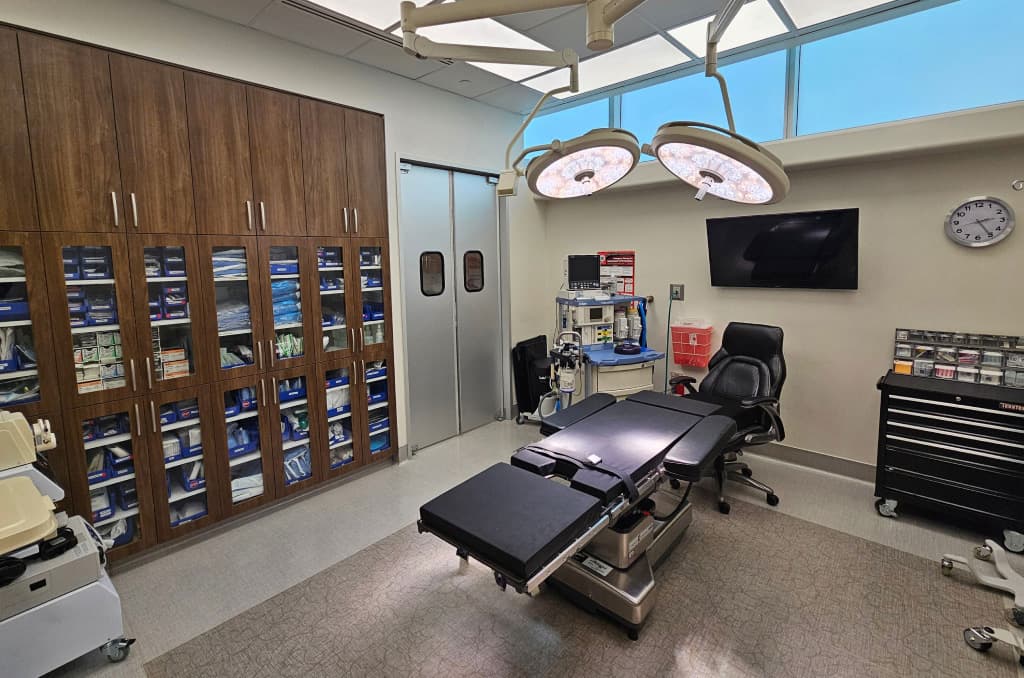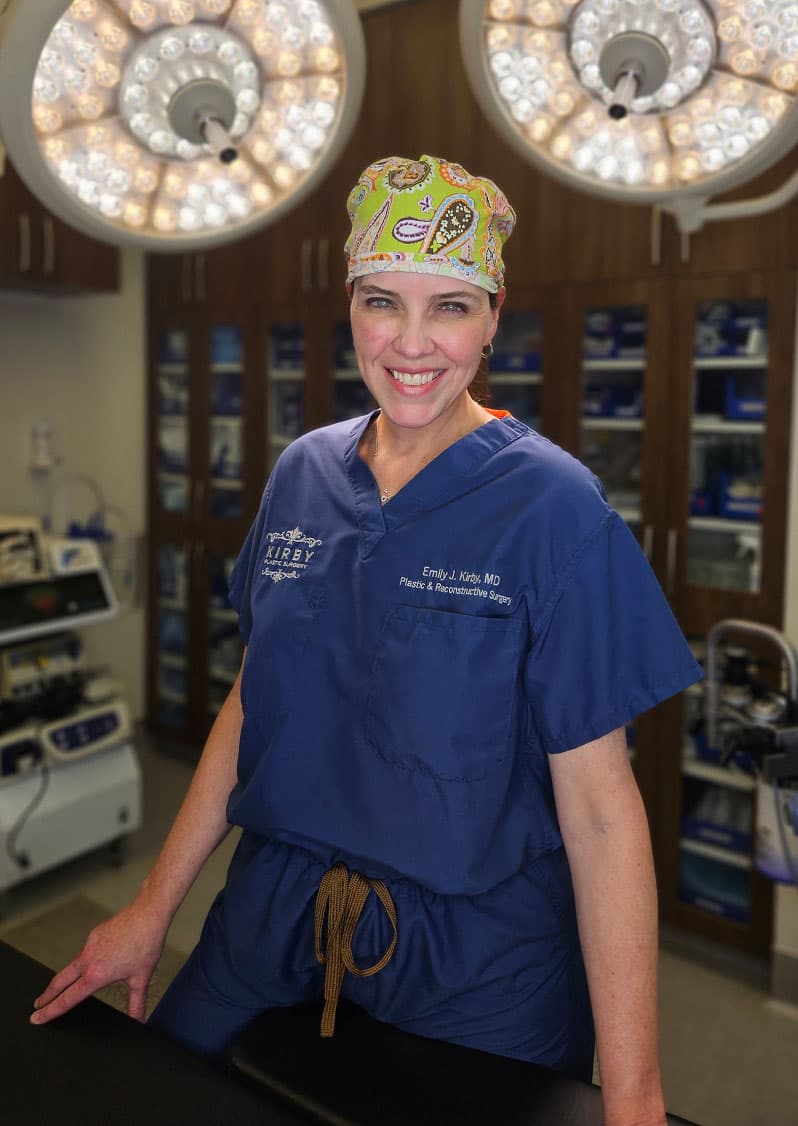Cheek Augmentation Fort Worth

High, prominent cheeks are considered cosmetically pleasing, but in some people the cheekbone is indistinct, resulting in a “flattened” appearance of the face. A flat face is typically caused by genetics, aging, or injuries to the face. Board Certified Plastic Surgeon Dr. Emily J. Kirby performs cheek augmentation in Fort Worth to emphasize the cheekbones and tighten facial skin & soft tissues, improving definition in the face.
What type of cheek implant will I have?
Surgical enhancement of the cheeks can be performed through an augmentation procedure using implants. There are several types of implants available and the choice depends on your specific anatomy. The main type of implant used is called Medpor® (porous polyethylene), but silicone, Gortex®, and hydroxyapatite (coral) can also be used. Dr. Kirby prefers Medpor because it is stable and has predictable results.
Female Plastic Surgeon Fort Worth
- Board-Certified Plastic Surgeon
- Over 14 years of experience in private practice
- Founder and Medical Director of Kirby Plastic Surgery, Kalos Medical Spa, and City Surgery Center—a Quad A-accredited, state-of-the-art facility located onsite
- Specialist in breast surgery and body contouring, including postpartum
- Castle Connolly Top Doctor since 2019
- First female Chief of Plastic Surgery, Texas Health Resources Harris Methodist Hospital
Your consultation with Dr. Kirby
Your consultation takes about one hour. You’ll spend most of that time with Dr. Kirby discussing your goals, concerns, and questions, and learning how Dr. Kirby tailors the procedure to address each of these. You’ll also get to meet our nursing staff who will take your vitals and review your medical history, and our patient care coordinator will schedule your procedure and help guide you through the process from start to finish.
What kind of anesthesia will I have?
Cheek augmentation is performed under general anesthesia for optimal comfort. This means you will be asleep for the entire procedure. Typically, the procedure is performed as outpatient surgery, but depending on your specific combination of procedures planned, you may need to stay overnight.
Where will my incisions be?
Cheek augmentation is usually performed through an incision in the mouth, placed just above the gum line. A pocket is created above the bony surface of the cheek to insert the implant. The implant is positioned and stabilized using a screw that provides stability to the implant during the healing phase. The screw is left in place permanently. The size of the implant and the amount of augmentation is decided ahead of time during a consultation with Dr. Kirby. This will help to provide a natural balance and proportion to your face.
- Key Benefits
- Glossary
- Adds definition to the cheekbones
- Promotes a younger-looking appearance
- May improve symmetry
- Anesthesia: Medication administered to prevent pain during surgery. There are several types, including local anesthesia, which numbs a small area; regional anesthesia, which blocks pain in a larger area; and general anesthesia, which induces sleep and relaxation.
- Cheek Augmentation: A cosmetic procedure that enhances the volume and contour of the cheeks using implants or injectable fillers.
- Cheek Implants: Specially designed biocompatible materials inserted over the cheekbones to add volume and definition to the face.
- Facial Contouring: A series of cosmetic procedures aimed at altering the facial structure to improve facial harmony and aesthetics, which can include cheek augmentation.
- Incision: A surgical cut made in the skin to perform surgery; in cheek augmentation, incisions are usually made inside the mouth or in the lower eyelid to minimize visible scarring.
- Malar Augmentation: Another term for cheek augmentation, specifically referring to enhancing the prominence of the cheekbones.
- Maxillofacial: Relating to the jaw and face, particularly with reference to the specialized surgical procedures that affect this area, including cosmetic enhancements.
- Submalar Augmentation: A procedure that targets the area below the cheekbones to correct hollow or sunken cheeks, providing a fuller appearance.
- Silicone Implants: A type of cheek implant made from medical-grade silicone.
- Biocompatible Materials: Substances that are compatible with the human body and can be used for medical applications, such as implants, without causing adverse reactions.
- Recovery Time: The period after surgery during which the patient heals. This includes time for swelling and bruising to subside, and for the patient to gradually return to normal activities, typically ranging from a few days to several weeks. Recovery can be streamlined, but not rushed.
How long is cheek augmentation surgery?
Cheek augmentation surgery usually takes 1 hour but will depend on your specific combination of procedures planned. You will be able to return home on the same day, several hours after your procedure.
What are the risks of cheek augmentation?
Cheek augmentation incisions are located inside the mouth and should heal easily. These incisions are not visible, and the scars are rarely problematic. Nevertheless, you should be aware that all scars are permanent and their height, width, and final color are unpredictable. As with any surgical procedure, small sensory nerves to the skin surface may be cut when the incision is made or when skin is undermined. Portions of your face will feel numb or have less than full feeling. The sensibility in these areas gradually returns, usually within 2 to 3 months as the nerve endings spontaneously heal.
During the healing process, the skin of the face may become hypersensitive for a period of time. Some diminished sensibility may last indefinitely. Bleeding is unusual but can occur after cheek augmentation. It occurs in about 1 to 2% of patients and is more common in men. Occasionally a minor deformity may persist following surgery. No one face is perfectly symmetrical; some post-operative asymmetry may be a result of asymmetry already present. A second procedure may be necessary to resolve the problem.
Swelling is a normal consequence of surgery and is best treated simply by elevating the head of the bed. Injury to the nerve that gives feeling to the cheek, upper lip, and side of the nose occurs in less than 1% of cases. When it does occur, it results in partial loss of feeling to that side of the face. Some numbness after surgery is normal but if the nerve is injured, then there could be permanent loss of feeling. Infection is also rare; prevention is the key and antibiotics will be provided after surgery.

City Surgery Center
Our on-site, accredited surgical suite
Instead of heading to a hospital or other public surgical facility for your procedure, you can enjoy the privacy and luxury of our on-site operating room, designed to facilitate safe, top-quality care in a spa-like setting.
How do I prepare for surgery?
Prior to any procedure, it is necessary to review medications you are taking that may affect your surgery. You may be asked to stop or adjust some medications you are on. As always, it is important to include supplements on your list of medications. Aspirin and aspirin products (Alka-Seltzer®, Carisoprodol, Excedrin®, Goody’s®, Midol®), anti-inflammatory medications (except acetaminophen, or Tylenol®), and herbal supplements must be avoided for 10 days prior to your surgery. Dr. Kirby will discuss your medications with you. Learn more about which medications and supplements to avoid.
Depending on your medical condition, you may be asked to get lab testing or a medical checkup prior to your surgery.
Tobacco products impair your body’s ability to heal. You will be asked to stop smoking for 6 weeks prior to any surgery. Tobacco step-down products such as chewing gum and Nicoderm® continue to provide your body with tobacco and must be stopped as well. Please ask Dr. Kirby if you will need assistance with quitting.
Be sure to arrange for a responsible adult to drive you to and from your surgery. You will need someone to stay with you the night following your surgery as well.
You will receive specific instructions for your surgery day from Dr. Kirby’s office.
Dr. Emily Kirby ensures that every plastic surgery patient receives Enhanced Recovery After Surgery (ERAS) care to optimize recovery time and minimize pain. Dr. Kirby uses innovative pain reduction techniques, such as numbing anesthetics and small doses of different types of medications, to reduce discomfort from many angles.
“Dr. Kirby has created the most amazing experience. She is thorough and intuitive, sincerely cares about the work she does and perfectly marries listening to what you want and what science says.”
—Actual patient
What is cheek augmentation recovery like?
There is minimal discomfort associated with cheek augmentation. There will be a moderate amount of swelling around the cheek area and possibly under the eyes, which peaks at 48 to 72 hours after surgery before starting to subside. Crushed ice applied to the cheeks will help during this time. Most of the visible swelling will disappear by about 2 weeks. There may still be a feeling of numbness, which means that some swelling is still present. It will take several weeks before the last bit of swelling has resolved.
You should not sleep on your face for at least 6 to 8 weeks following surgery. Oral pain medication is used to control your post-operative discomfort.
The incisions in the mouth are closed with dissolvable stitches. You should be able to brush your teeth after surgery, but should take extra care when brushing your upper teeth. You should turn the toothbrush vertically and watch yourself brush each individual tooth to make sure you do not disrupt the fresh gum line incision. Your diet should be liquids (juices, milk, shakes, broths, etc.) for the first 24 hours, after which you may start a soft diet. You should not eat foods that are hard or sharp (chips, Doritos®, etc.) for 6 to 8 weeks after surgery.
Caring for your incisions after plastic surgery
Proper incision care is essential to a smooth recovery and ensuring your scars heal as beautifully as possible.
References »
Mladick RA. Alloplastic cheek augmentation. Clinics in Plastic Surgery. 1991 Jan;18(1):29-38.
Jumaily JS. Cheek Augmentation in Gender-Affirming Facial Surgery. Otolaryngologic Clinics of North America. 2022 Aug;55(4):825-834. doi: 10.1016/j.otc.2022.05.004.
Whitehead DM, Schechter LS. Cheek Augmentation Techniques. Facial Plastic Surgery Clinics of North America. 2019 May;27(2):199-206. doi: 10.1016/j.fsc.2018.12.003.
- Discuss your goals and concerns
- Obtain a unique female perspective
- Review convenient financing options
- call or TEXT (817) 292-4200 or contact us online today!
Areas Served:

Medically reviewed by Dr. Emily J. Kirby — Updated on Feb 7, 2025
